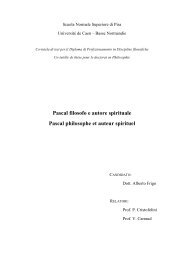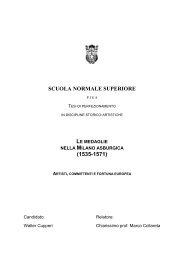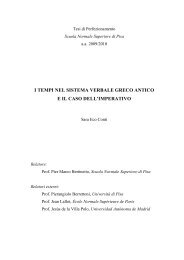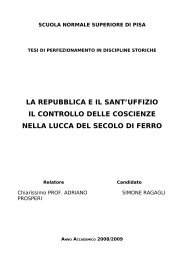CATULLUS 68 - Scuola Normale Superiore
CATULLUS 68 - Scuola Normale Superiore
CATULLUS 68 - Scuola Normale Superiore
Create successful ePaper yourself
Turn your PDF publications into a flip-book with our unique Google optimized e-Paper software.
THE TRANSMISSION AND THE RECONSTRUCTION OF THE TEXT<br />
The earliest four surviving manuscripts of the poems of Catullus, except of carmen 62, are the following: 154<br />
O The MS Canonicianus classicus latinus 30 of the Bodleian Library in Oxford. O was written in elegant<br />
Italo-Gothic letters by a calligrapher who was “an abysmally poor Latinist”. 155 It was left incomplete: no<br />
titles and hardly any initials have been added in the empty spaces that have been spared out for them. 156 A<br />
handful of marginal notes have been taken over from the exemplar (see line 66n.). The style of the writing<br />
shows that it was written somewhere in Northern Italy in the 14 th century. 157<br />
G The codex Parisinus latinus 14137 in the Bibliothèque Nationale de France in Paris, once conserved in<br />
the abbey of St-Germain-des-Prés, whence its siglum G. The scribe was identified by Giuseppe Billanovich<br />
as Antonio del Gaio da Legnago (ca. 1350-1385), the disreputable Chancellor of Cansignorio della Scala<br />
(1340-1375, ruler of Verona from 1359 onwards). 158 In the subscriptio Da Legnago notes that he finished the<br />
manuscript on 19 October 1375, as Cansignorio lay dying. G too was left incomplete, like O: Da Legnago<br />
left lines empty for the titles, but left most of these empty, and took over only a handful of the marginal notes<br />
that were (as we shall see) present in his exemplar. Cansignorio died shortly after he completed the text of<br />
the MS, and he undoubtedly had more urgent business to attend to. 159<br />
R The codex Ottonobianus latinus 1829 in the Biblioteca Apostolica Vaticana. It was copied by a<br />
professional scribe for Lino Coluccio Salutati (1331-1406, Chancellor of the Florentine Republic from<br />
1375). Salutati then went over the text himself and checked the MS against its exemplar, copying titles and<br />
marginalia (apart from some rare cases in which these had already been added by the scribe), inventing more<br />
titles and making conjectures of his own. Since O and G were left incomplete, Salutati (R 2 ) is our best source<br />
for fourteenth-century titles and marginalia; however, one must try to distinguish those that he copied from<br />
154<br />
For a more detailed account of these MSS see Thomson 1997: 28-38.<br />
155<br />
Thomson 1997: 28.<br />
156<br />
Thomson loc. cit. suggests that “O … may well have been set aside in favour of the more faithful rendering which X<br />
gives of A’s text” – that is to say, O would have been set apart because someone would have realized that it contained<br />
too many mistakes. In fact it is not unusual to find manuscripts in which the titles, the initials and/or the marginalia<br />
were not added: this is also the case with G (see above). If anybody had checked the text of O when it was copied, he<br />
would surely have tried to correct at least part of the mistakes, and there is no trace of this. It simply appears to be due<br />
to chance that O was never completed.<br />
157<br />
Thus McKie 1977: 242, n. 1. Thomson 1997 dates O to “?ca. 1360” in his Introduction (p. 28) and to “ca. 1370?” in<br />
his Table of Manuscripts (p. 81). Either date would be strongly hypothetical.<br />
158<br />
Billanovich 1959: 160-167, who gives more information on this unsavoury character.<br />
159 Thus McKie 1977: 178 and Thomson 1997: 31.<br />
74






